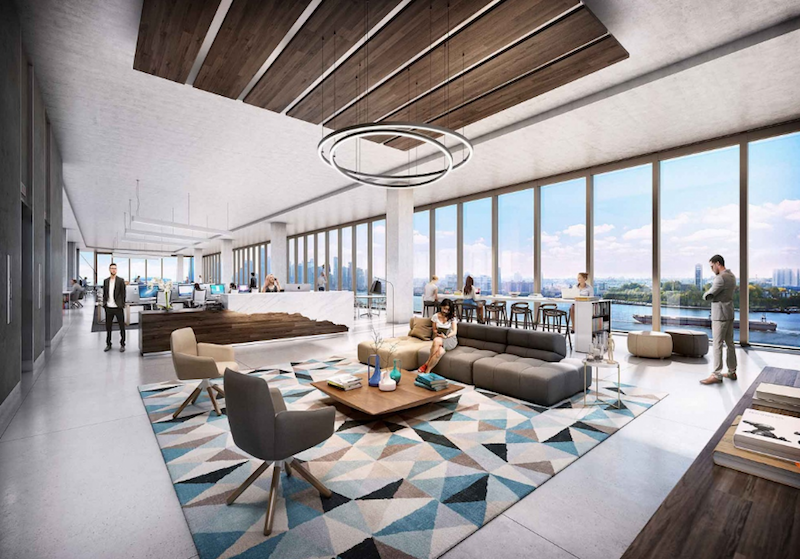When designing a new office building located between Manhattan’s High Line Park and the Hudson River, Studio Gang wanted to protect the views between the park and the river and block as little sunlight as possible. The firm’s solution to this problem was to take on the sun as a freelance designer.
Expanding upon its “solar carving” design strategy, Studio Gang used incident angles of the sun’s rays to sculpt the Solar Carve Tower’s form. The result is a gem-like façade that allows light, fresh air, and river views to reach the park.
At any point during the year, the sun’s rays will be able to pour around the building’s unique façade, which takes the shape of an hourglass made up of smaller diamond-shaped carvings, to reach the surrounding park and green space.
On its website, Studio Gang says, “Solar Carve Tower explores how shaping a building in response to solar access and other site-specific criteria can expand its architectural potential.”
Each of the building’s floors will provide office space ranging from 13,700 sf to 14,200 sf, the New York Post reports. 16-foot-high floor-to-ceiling windows will provide each floor with natural light, views, and connectivity to the natural environment. Solar Carve Tower will also include 17,000 sf of ground floor retail. In total, the new tower will provide 166,750 sf of space.
The project is targeting LEED Gold.
 Rendering courtesy of Studio Gang.
Rendering courtesy of Studio Gang.
 Rendering courtesy of Studio Gang.
Rendering courtesy of Studio Gang.
 Rendering courtesy of Studio Gang.
Rendering courtesy of Studio Gang.
 Rendering courtesy of Studio Gang.
Rendering courtesy of Studio Gang.
 Image courtesy of Studio Gang.
Image courtesy of Studio Gang.
Related Stories
| Apr 13, 2011
Former department store gets new lease on life as MaineHealth HQ
The long-vacant Sears Roebuck building in Portland, Maine, was redeveloped into the corporate headquarters for MaineHealth. Consigli Construction and local firm Harriman Architects + Engineers handled the 14-month fast-track project, transforming the 89,000-sf, four-story facility for just $100/sf.
| Mar 29, 2011
Chicago’s Willis Tower to become a vertical solar farm
Chicago’s iconic Willis Tower (formerly the Sears Tower) is set to become a massive solar electric plant with the installation of a pilot solar electric glass project.
| Mar 29, 2011
Read up on Amazon.com's new green HQ
Phase IV of Amazon’s new headquarters in Seattle is nearly complete. The company has built 10 of the 11 buildings planned for its new campus in the South Lake Union neighborhood, and is on-track for a 2013 grand opening.
| Mar 11, 2011
Blockbuster remodel transforms Omaha video store into a bank
A former Hollywood Video store in Omaha, Neb., was renovated and repurposed as the SAC Federal Credit Union, Ames Branch. Architects at Leo A Daly transformed the outdated 5,000-sf retail space into a modern facility by wrapping the exterior in poplar siding and adding a new glass storefront that floods the interior with natural light.
| Mar 11, 2011
Chicago office building will serve tenants and historic church
The Alter Group is partnering with White Oak Realty Partners to develop a 490,000-sf high-performance office building in Chicago’s West Loop. The tower will be located on land owned by Old St. Patrick’s Church (a neighborhood landmark that survived the Chicago Fire of 1871) that’s currently being used as a parking lot.
| Mar 9, 2011
Hoping to win over a community, Facebook scraps its fortress architecture
Facebook is moving from its tony Palo Alto, Calif., locale to blue-collar Belle Haven, and the social network want to woo residents with community-oriented design.
| Feb 14, 2011
More companies willing to pay extra for green office space
New CoreNet Global/Jones Lang LaSalle survey shows real estate executives forging green strategies that balance environmental, financial and workforce issues.
| Feb 11, 2011
RS Means Cost Comparison Chart: Office Buildings
This month's RS Means Cost Comparison Chart focuses on office building construction.
| Feb 11, 2011
Kentucky’s first green adaptive reuse project earns Platinum
(FER) studio, Inglewood, Calif., converted a 115-year-old former dry goods store in Louisville, Ky., into a 10,175-sf mixed-use commercial building earned LEED Platinum and holds the distinction of being the state’s first adaptive reuse project to earn any LEED rating. The facility, located in the East Market District, houses a gallery, event space, offices, conference space, and a restaurant. Sustainable elements that helped the building reach its top LEED rating include xeriscaping, a green roof, rainwater collection and reuse, 12 geothermal wells, 81 solar panels, a 1,100-gallon ice storage system (off-grid energy efficiency is 68%) and the reuse and recycling of construction materials. Local firm Peters Construction served as GC.
| Feb 11, 2011
Chicago architecture firm planning one of China’s tallest towers
Chicago-based Goettsch Partners was commissioned by developer Guangzhou R&F Properties Co. Ltd. to design a new 294,570-sm mixed-use tower in Tianjin, China. The Tianjin R&F Guangdong Tower will be located within the city’s newly planned business district, and at 439 meters it will be one of China’s tallest buildings. The massive complex will feature 134,900 sm of Class A office space, a 400-key, five-star hotel, 55 condominiums, and 8,550 sm of retail space. The architects are designing the tower with multi-story atriums and a high-performance curtain wall to bring daylight deep into the building, thereby creating deeper lease spans. The project is currently finishing design.















